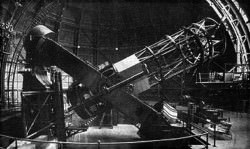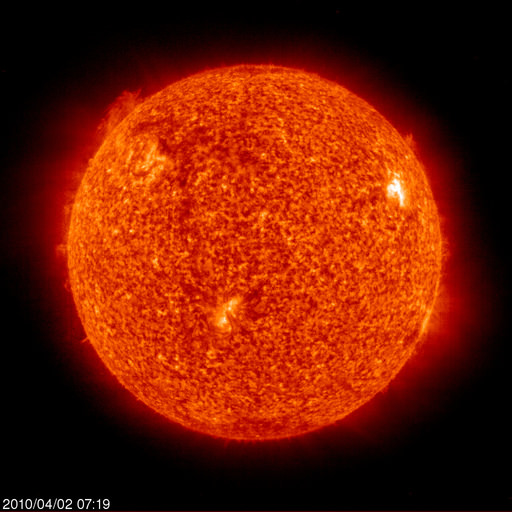Greetings, fellow SkyWatchers! Have you been out enjoying the Sun? You better be, because the Sun has been enjoying you and putting on quite a show! Once it sets, be sure to look for both Venus and Mercury decorating the western skyline. With the Moon gone off the early evening scene, it’s also time to take on a couple of new galactic open cluster studies to tease your eye with photons! Whenever you’re ready, I’ll see you in the dark…
 April 2, 2010 – On this date in 1889, the Harvard Observatory’s 13″ refractor arrived at Mt. Wilson. Just one month later, it went into astronomical service at Lick Observatory, located at Mt. Hamilton. It was here that the largest telescopes in the world resided from 1908 to 1948 – the 60″ for the first decade, then the 100″. This latter mirror is still the largest solid piece ever cast in plate glass, and weighed 4.5 tons. Would you believe it’s just 13″ thick?
April 2, 2010 – On this date in 1889, the Harvard Observatory’s 13″ refractor arrived at Mt. Wilson. Just one month later, it went into astronomical service at Lick Observatory, located at Mt. Hamilton. It was here that the largest telescopes in the world resided from 1908 to 1948 – the 60″ for the first decade, then the 100″. This latter mirror is still the largest solid piece ever cast in plate glass, and weighed 4.5 tons. Would you believe it’s just 13″ thick?
This date in 1845, the first photograph of the Sun was taken. Although solar photography and observing is the domain of properly filtered telescopes, no special equipment is necessary to see some effects of the Sun, only the correct conditions. Right now Earth’s magnetosphere and magnetopause (the point of contact) are positioned correctly to interact with the Sun’s influencing interplanetary magnetic field (IMF), and the plasma stream that flows past us as the solar wind. During the time around equinox, this leaves the door wide open for one of the most awesome signs of spring – aurora! Visit the Geophysical Institute to sign up for aurora alerts, and use their tools to help locate the position of Earth’s auroral oval.
So is the Sun active right now? You betcha’. According to Spaceweather.com: “Amateur astronomers around the world are monitoring a huge prominence rising over the Sun’s northeastern limb. Magnetic fields underpinning this magnificent structure are in a state of fairly rapid motion, pulling the plasma to and fro, offering a different profile to every observer. The whole thing could become unstable and collapse.”
After you’ve enjoyed today’s Sun, be sure to watch as it sets for the brilliant appearance of Venus. Look closely to the northwest and you’ll see another planet, too. Mercury has come round from behind the Sun and is visible for a short time. If you don’t spot it at twilight, don’t despair. By week’s end, the two planets will be just 3 degrees apart!
April 3, 2010 – Tonight let’s try for a scattered open cluster, NGC 2281 (RA 06 48 18 Dec +41 05 00) toward the west in Auriga. At magnitude 5.4, NGC 2281 should be visible as a nebulous mist in binoculars on a dark night, but you’ll need a scope and high power to darken the sky enough to see the bright members found near its core.
NGC 2281 is around 1,500 light-years distant and 50 million years old. It can best be found by extending a line from Capella to Beta Aurigae an equal distance east to a pair of 5th magnitude stars separated by a finger-width. NGC 2281 lies less than a degree southeast of the eastern member of this pair (58 Aurigae). When studied photometrically, NGC 2281’s binary stars were found to congregate more toward the center of the cluster, and with more intensity than for single stars alone. With a population of no more than 60 stars, the binaries far outnumber their counterparts!
April 4, 2010 – Today we celebrate the 1809 birth on this date of astronomer Benjamin Peirce. Peirce was a professor of astronomy and mathematics for nearly 40 years and contributed greatly to the discovery of Neptune.
If you like challenging planetary nebulae studies, here’s a good one to try tonight – NGC 2610 (RA 08 33 23 Dec –16 08 58) near the Hydra/Puppis/Pyxis border.
At 13th magnitude, it’s not for the beginner, but a worthy study for seasoned veterans. Its position near two 7th magnitude stars will help reveal its location at low power. Magnify to catch a slightly elliptical shell, a stellar point on its northeast edge, and a wink of a central star. Note NGC 2610 is also cataloged as Herschel IV 65 – another to add to your ‘‘Herschel Hit List!’’
Have a terrific holiday weekend!
This week’s awesome images are: Hooker Telescope courtesy of NASA, latest H-Alpha image courtesy of SOHO, NGC 2281 and NGC 2610 from Palomar Observatory, courtesy of Caltech. We thank you so much!





Thanks for the update and inspiration Tammy! Now.. if only the rain would stop and I’d get some clear skies! Then it would be – HI-HO! Its up the mountain I go! ~@; )
“rain, rain… go away… come again another day!”